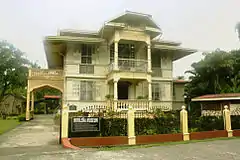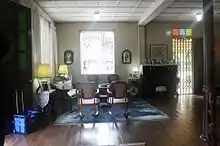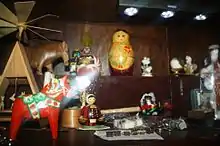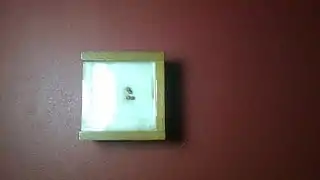Hofileña Ancestral House
The Hofileña Ancestral House is the residence of the late Manuel Severino Hofileña and his family located in Cinco de Noviembre Street, Silay City, in the province of Negros Occidental, Philippines. The home was built by Hofileña for his wife Gilda Ledesma Hojilla, a former Miss Silay,[2] and their nine children.
 The facade of the Hofileña Ancestral House | |
.svg.png.webp) Location within Philippines | |
| Established | 1962[1] |
|---|---|
| Location | Cinco de Noviembre Street, Silay City, Negros Occidental, Philippines |
| Coordinates | 10.801984°N 122.974268°E |
| Type | Lifestyle museum |
| Curator | Ramon Hofileña |
At present, Ramon Hofileña, one of the children and heirs, resides in this ancestral house and personally tours guests who visit his abode.
History
Silay City's stone houses, or bahay na bato—most of which are owned by landed farmers and sugar barons—are material reminders of the life of the affluent in the late 19th century to the early 20th century, the golden age of Silay and the peak of the sugar industry in the province.[1][3] One of these houses, the Hofileña Ancestral House, was built in 1934.[4]
During World War II, when the family fled to the mountains, the house was used by Japanese commanders who had meetings here.[1] The house was later occupied by the Americans.[4]
In 1962 the house was opened to the public. It was the first ancestral house to be opened in the city.[1] The next house to do so was 30 years later.[5]

The Hofileña Ancestral House has a historical marker installed by the National Historical Commission of the Philippines (NHCP) on April 6, 1993.[6]
In 1989, the BBC TV series "Far Eastern Cookery" shot some of its scenes in the Hofileña Ancestral House when it featured Ilonggo delicacies. The house was also used as a setting by a Canadian movie company for its documentary on Sugarlandia, which was shown at the Toronto Film Festival in 2011.[7]
Art & architecture
Since it was built in the 1930s, the period when Art Deco and Art Nouveau flourished in the country, the Hofileña Ancestral House also reflects such styles. Most of its architectural details were influenced by other houses. Its roof is of classic steep and wide eaves, unlike the galvanized iron sheets that have been the popular roofing material in Manila. The wide steps that lead to the portico is of American influence.[4]
Materials used were hardwood. The grand staircase, which came from Gilda Hofileña's ancestral house, is made of ironwood, or "balayong", which is not susceptible to termites and impenetrable by nails. The balustrades were individually carved by carpenters.[7]

The floor is made of narra, and polished regularly, giving it a shiny surface. The walls are made of balayong as well. The doors are wide and have tracery cutwork, also known as callado, that provides space for air and light to pass through.[4]
Hofileña's living room, or sala, displays old photos of every family member. On top of its 200-year-old German Steinweig piano stand the photos of the nine siblings, each one of them involved in the arts. There are Spanish chairs in this room and a hand-carved kamagong sofa.[4]
The sala leads to a smaller room, a library, where a vast collection of books, albums, and souvenir items are kept. The bookshelves contain Filipiniana books, some of which were authored by Ramon Hofileña, and the world's first pocketbooks for World War II American soldiers. There were also religious images, such as the wooden image of San Vicente Ferrer (Saint Vincent Ferrer).[1]
One of the cupboards display the toys Hofileña has amassed throughout his travels. What Hofileña claims as the world's smallest dolls are kept behind the glass-paneled cabinet doors. He also has some sought-after tektite stones as one of his collections.[8]

The dining room, or comedor, features cabinets of antique pieces, such as Chinese porcelain wares and jars from the Ming dynasty. Some of them date back as far as 3,000 years ago, like the old Israeli oil juglet. The dining area is also where the first wood-printing in Negros happened.[9] The machine has remained in this room where Mr. Hofileña often demonstrates the art of paper printing to guests.
The bedroom is adorned by a four-poster bed made of narra wood. The beddings are made of embroidery, typical of most Filipino households in the 20th century.

Apart from its overall look, the house is also a repository of art finds collected by the owner-curator Ramon Hofileña and his family. The second floor is a gallery of over 1,000 art treasures, featuring the paintings and sketches of national artists Juan Luna, Felix Resurrecion Hidalgo, Fernando Amorsolo, Ang Kiukok, Vicente Manansala, H.R. Ocampo, and BenCab. Alongside these master's works is a sketch made by the young Jose Rizal, the national hero, and a painting by Spanish artist Francisco Goya.[4]
References
| Wikimedia Commons has media related to Hofileña Ancestral House. |
- Betancourt, Daniel (December 2007). "Housing Our Rich Past". Cebu Smile. Smile Magazine. Retrieved 13 September 2014.
- "Film on Hofileña house showing Friday". The Visayan Daily Star. Visayan Daily Star, Inc. 14 June 2012. Retrieved 13 September 2014.
- Villalon, August (24 June 2012). "The aging ladies of Silay". Philippine Daily Inquirer. Philippine Daily Inquirer, Inc. Retrieved 13 September 2014.
- Enriquez, Marge (29 September 2010). "Negrense home holds stunning collection". Philippine Daily Inquirer. Philippine Daily Inquirer, Inc. Archived from the original on 7 October 2014. Retrieved 13 September 2014.
- Tantengco, Cristina (26 June 2013). "48 Hours in Bacolod: A 'Biyahe ni Drew' itinerary". GMA News and Public Affairs. Retrieved 13 September 2014.
- Maranga, Mark Anthony (29 September 2010). "Hofileña Ancestral House". Philippines Travel Guide. Retrieved 6 December 2010.
- Hofileña, Ramon. "Hofileña Heritage House". Dakbanwang Silay. Retrieved 13 September 2014.
- Damo, Ida Nanette (28 July 2014). "4 Must-Sees in Historic Silay: Travel Back in Time!". Choose Philippines. Choose Philippines. Retrieved 13 September 2014.
- Gazo, Betsy (5 May 2012). "Ramon Hofileña: Silay's Icon". Sun.Star Bacolod. Sun.Star Publishing, Inc. Retrieved 13 September 2014.